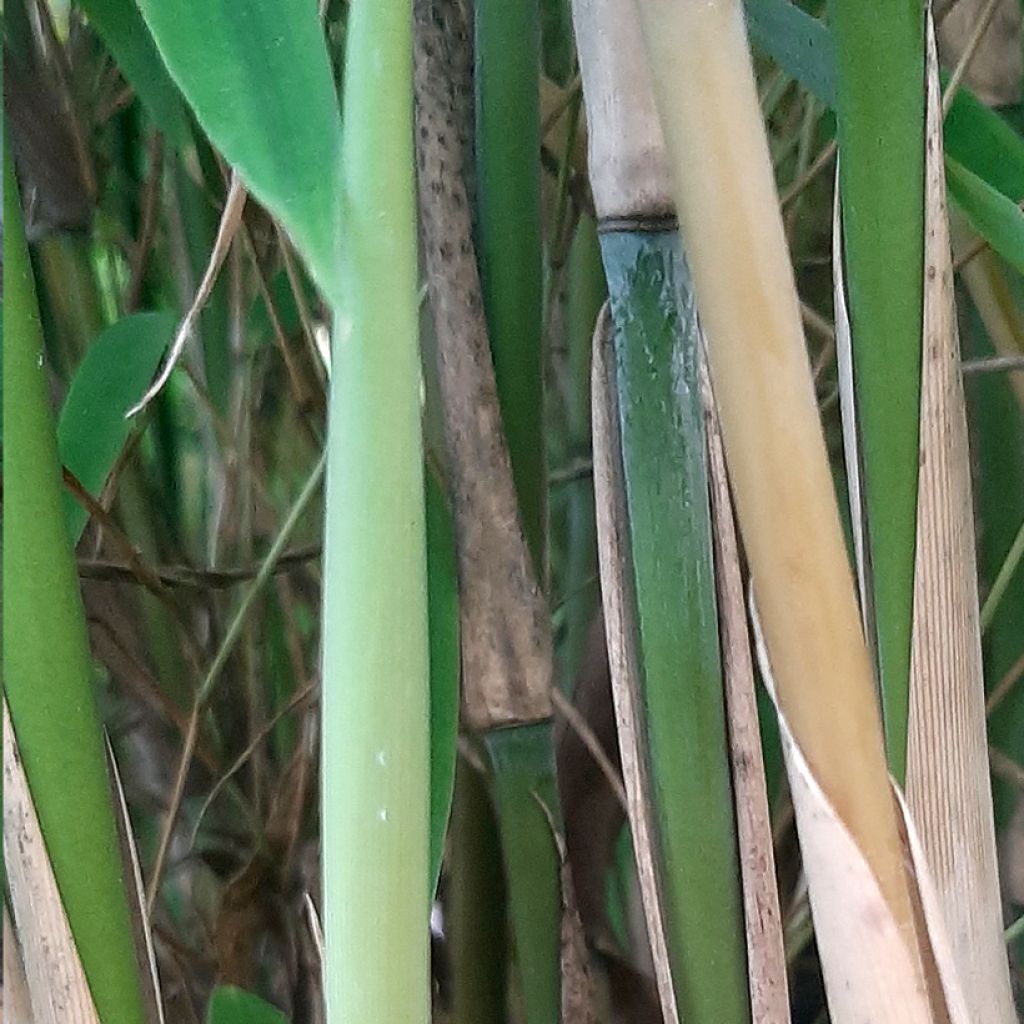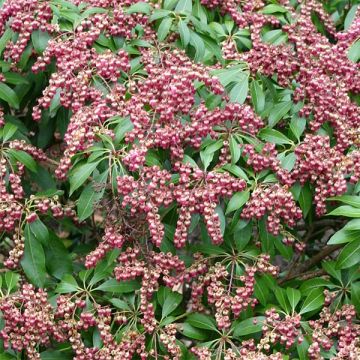

Fargesia murielae Ivory Ibis - Non-running bamboo
Fargesia murielae Ivory Ibis - Non-running bamboo
Fargesia murielae Ivory Ibis ®
Special offer!
Receive a €20 voucher for any order over €90 (excluding delivery costs, credit notes, and plastic-free options)!
1- Add your favorite plants to your cart.
2- Once you have reached €90, confirm your order (you can even choose the delivery date!).
3- As soon as your order is shipped, you will receive an email containing your voucher code, valid for 3 months (90 days).
Your voucher is unique and can only be used once, for any order with a minimum value of €20, excluding delivery costs.
Can be combined with other current offers, non-divisible and non-refundable.
Home or relay delivery (depending on size and destination)
Schedule delivery date,
and select date in basket
This plant carries a 24 months recovery warranty
More information
We guarantee the quality of our plants for a full growing cycle, and will replace at our expense any plant that fails to recover under normal climatic and planting conditions.
Would this plant suit my garden?
Set up your Plantfit profile →
Description
Fargesia murielae Ivory Ibis is a non-invasive bamboo, suitable for planting in isolation but especially ideal for forming a dense and decorative hedge. In a few years, its beautiful dark green vegetation will reach 3.50 to 4 m in height, without spreading uncontrollably. Showing excellent cold resistance, comfortable in any good garden soil, preferably neutral to acidic, this variety adapts to many regions. It does not require a rhizome barrier (while keeping in mind that the clumps widen over the years by producing new shoots which do not appear at a distance like with running bamboo).
Fargesia murielae is a plant of the Poaceae family, a type of woody-stemmed grass that develops from a non-invasive rhizomatous crown, known as clump-forming. In this type of bamboo, the rhizomes with very short internodes develop slowly at the periphery of the stump, which gradually widens, but they also develop towards the center of the crown, which remains very dense without thinning out in the middle. This umbrella bamboo, also known as Sinarundinaria murielae, is native to the mountains of central China and is one of the hardiest bamboos (-26°C). It has survived in Eastern European countries with very harsh winters.
This cultivar 'Ivory Ibis' is a recent horticultural variety from the Well Born Bamboo Africa range, obtained by sowing and selecting the best specimens. It originates from China, in a valley in the Hubei province following a flowering of mother bamboos between 1998 and 2000. It forms a compact clump at the base, spreading upwards like an umbrella, reaching 3.5 to 4 m in height and about 2 m in width. The dark green canes (stems) are slender and elongated, measuring approximately 2 cm in diameter. This plant is called ivory bamboo because the canes have light-coloured sheaths, ranging from cream to ivory, which contrasts beautifully with the dark stems. The long and narrow leaves taper to a point at their tip and are also quite dark green and slightly shiny.
This bamboo grows in most soils, from moist to wet, but not waterlogged. A rich soil will promote its growth, as well as a sunny to semi-shaded exposure. It also tolerates shade but will grow a little less. It is remarkably hardy, down to -26°C without any issues. With good pruning, it will form beautiful dense hedges and can also be planted in containers, limiting its height with shears.
Fargesia murielae Ivory Ibis, with its dense canes and foliage is evergreen and of fairly rapid growth, perfect for creating a decorative or protective hedge. It is resistant to wind and forms a curtain of vegetation that completely conceals. The umbrella bamboo is an architectural plant par excellence and will elegantly enhance a contemporary garden. You can also plant it as a background in an exotic scene, in which the Chinese windmill palm (Trachycarpus fortunei) will make a good impression with its fibrous trunk and large, highly decorative palm leaves, evocative of distant lands. Tetrapanax papyrifera 'Rex' with its immense and uniquely shaped palmate leaves will also give a very distinctive style to your flower bed. To complete the scene, nothing beats a banana tree for a tropical look. Musa basjoo, very cold-resistant, will take care of that with its typical, immense leaves that can exceed 2 m in length...
Report an error about the product description
Fargesia murielae Ivory Ibis - Non-running bamboo in pictures


Plant habit
Foliage
Botanical data
Fargesia
murielae
Ivory Ibis ®
Poaceae
Cultivar or hybrid
Other Fargesia
View all →Planting and care
Fargesia murielae Ivory Ibis tolerates full sun but can also be planted in partial shade. Plant this bamboo in rich soil that remains slightly moist in summer, preferably heavy and water-retentive (as a reference, the mature plant requires about 20 litres of water per week in hot periods and 10 litres the rest of the year). This Fargesia will grow in neutral or slightly acidic soil, preferably without limestone. If necessary, replace the soil in your garden with good horticultural compost. Plant in spring or autumn, and to create a hedge, plant one every 60 cm to obtain a dense green curtain.
In pots, monitor the watering, especially when the foliage is very abundant, and apply 2 handfuls of lawn fertiliser at the base of your non-invasive bamboo from early March to mid-April. This will make its foliage greener. This bamboo tolerates pruning very well, so its width can easily be limited with shears to maintain a narrow hedge.
Like all other Fargesia, this non-invasive bamboo does not require the installation of a rhizome barrier at planting. However, please note that non-invasive does not mean that it will not spread over the years. The clump will indeed grow, but gradually, without producing long rhizomes that will shoot two metres away. It retains its green foliage throughout winter and loses some leaves throughout the year, more so towards the end of autumn. These leaves accumulate at the base of the canes, forming a protective mulch against soil dehydration, which is why it is best to leave them in place.
Planting period
Intended location
Care
This item has not been reviewed yet - be the first to leave a review about it.
Similar products
Haven't found what you were looking for?
Hardiness is the lowest winter temperature a plant can endure without suffering serious damage or even dying. However, hardiness is affected by location (a sheltered area, such as a patio), protection (winter cover) and soil type (hardiness is improved by well-drained soil).

Photo Sharing Terms & Conditions
In order to encourage gardeners to interact and share their experiences, Promesse de fleurs offers various media enabling content to be uploaded onto its Site - in particular via the ‘Photo sharing’ module.
The User agrees to refrain from:
- Posting any content that is illegal, prejudicial, insulting, racist, inciteful to hatred, revisionist, contrary to public decency, that infringes on privacy or on the privacy rights of third parties, in particular the publicity rights of persons and goods, intellectual property rights, or the right to privacy.
- Submitting content on behalf of a third party;
- Impersonate the identity of a third party and/or publish any personal information about a third party;
In general, the User undertakes to refrain from any unethical behaviour.
All Content (in particular text, comments, files, images, photos, videos, creative works, etc.), which may be subject to property or intellectual property rights, image or other private rights, shall remain the property of the User, subject to the limited rights granted by the terms of the licence granted by Promesse de fleurs as stated below. Users are at liberty to publish or not to publish such Content on the Site, notably via the ‘Photo Sharing’ facility, and accept that this Content shall be made public and freely accessible, notably on the Internet.
Users further acknowledge, undertake to have ,and guarantee that they hold all necessary rights and permissions to publish such material on the Site, in particular with regard to the legislation in force pertaining to any privacy, property, intellectual property, image, or contractual rights, or rights of any other nature. By publishing such Content on the Site, Users acknowledge accepting full liability as publishers of the Content within the meaning of the law, and grant Promesse de fleurs, free of charge, an inclusive, worldwide licence for the said Content for the entire duration of its publication, including all reproduction, representation, up/downloading, displaying, performing, transmission, and storage rights.
Users also grant permission for their name to be linked to the Content and accept that this link may not always be made available.
By engaging in posting material, Users consent to their Content becoming automatically accessible on the Internet, in particular on other sites and/or blogs and/or web pages of the Promesse de fleurs site, including in particular social pages and the Promesse de fleurs catalogue.
Users may secure the removal of entrusted content free of charge by issuing a simple request via our contact form.
The flowering period indicated on our website applies to countries and regions located in USDA zone 8 (France, the United Kingdom, Ireland, the Netherlands, etc.)
It will vary according to where you live:
- In zones 9 to 10 (Italy, Spain, Greece, etc.), flowering will occur about 2 to 4 weeks earlier.
- In zones 6 to 7 (Germany, Poland, Slovenia, and lower mountainous regions), flowering will be delayed by 2 to 3 weeks.
- In zone 5 (Central Europe, Scandinavia), blooming will be delayed by 3 to 5 weeks.
In temperate climates, pruning of spring-flowering shrubs (forsythia, spireas, etc.) should be done just after flowering.
Pruning of summer-flowering shrubs (Indian Lilac, Perovskia, etc.) can be done in winter or spring.
In cold regions as well as with frost-sensitive plants, avoid pruning too early when severe frosts may still occur.
The planting period indicated on our website applies to countries and regions located in USDA zone 8 (France, United Kingdom, Ireland, Netherlands).
It will vary according to where you live:
- In Mediterranean zones (Marseille, Madrid, Milan, etc.), autumn and winter are the best planting periods.
- In continental zones (Strasbourg, Munich, Vienna, etc.), delay planting by 2 to 3 weeks in spring and bring it forward by 2 to 4 weeks in autumn.
- In mountainous regions (the Alps, Pyrenees, Carpathians, etc.), it is best to plant in late spring (May-June) or late summer (August-September).
The harvesting period indicated on our website applies to countries and regions in USDA zone 8 (France, England, Ireland, the Netherlands).
In colder areas (Scandinavia, Poland, Austria...) fruit and vegetable harvests are likely to be delayed by 3-4 weeks.
In warmer areas (Italy, Spain, Greece, etc.), harvesting will probably take place earlier, depending on weather conditions.
The sowing periods indicated on our website apply to countries and regions within USDA Zone 8 (France, UK, Ireland, Netherlands).
In colder areas (Scandinavia, Poland, Austria...), delay any outdoor sowing by 3-4 weeks, or sow under glass.
In warmer climes (Italy, Spain, Greece, etc.), bring outdoor sowing forward by a few weeks.


















































